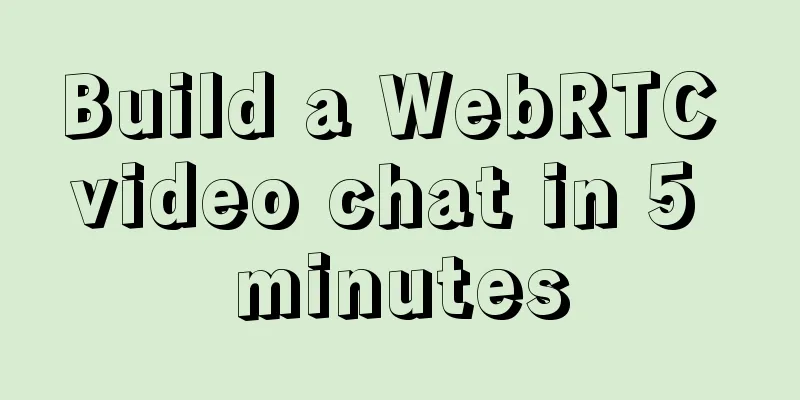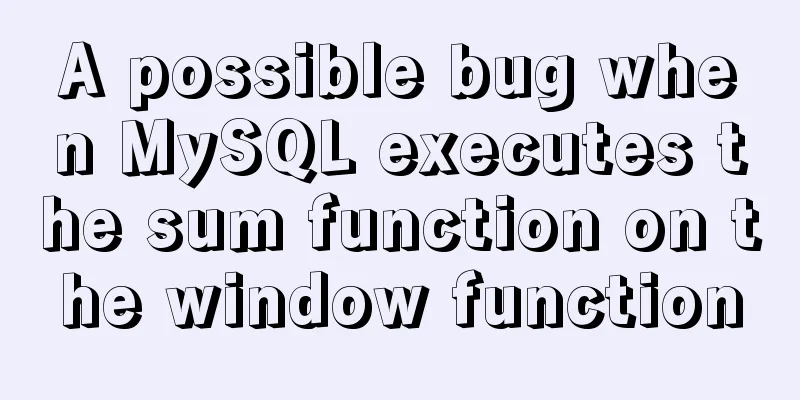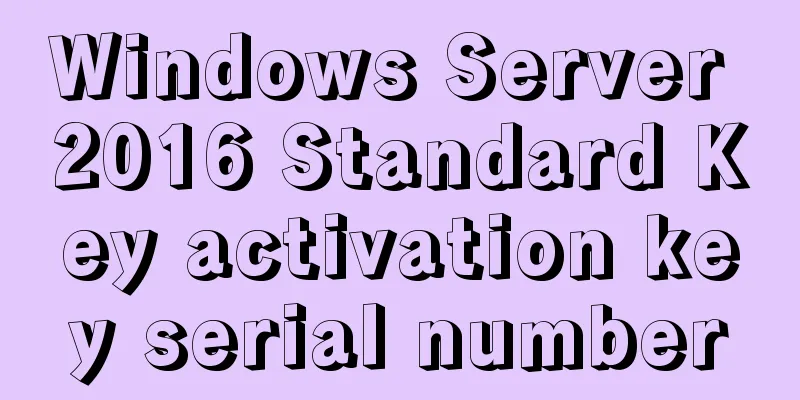Build a WebRTC video chat in 5 minutes

|
In the previous article, I introduced the detailed code of a multi-person video chat service based on webrtc on Ubuntu. Interested friends can refer to it. Today I will share with you an article about building a WebRTC video chat in 5 minutes. Just search WebRTC on Baidu, I think there are a lot of them. I thought I could use SkyRTC-demo from this friend (Building WebRtc Environment) to chat easily, but after struggling for a long time, I couldn't even send text messages, let alone video. So I did it myself. To achieve video communication on the public Internet, the following three core elements are required:
The three parts are composed as follows:
The blue part can actually be deployed on three servers, but the demonstration environment here is on one server. The ports that need to be opened are 3478, 8888, and 8080. Of course, you can also configure them yourself. The following are the detailed combination steps: PreparationServer operating environment: centos 7.3 Installation tools: nodejs, git, please install it by Baidu Client environment: FireFox (or mobile version of FireFox). Because Chrome requires https support, the server needs to deploy a certificate. So the demo program only supports Firefox. If necessary, I will post another article to introduce it. Installing NAT Traversal Server (ICE Server)There are two main ways to achieve intranet penetration: stun and turn. Generally, the addresses of stun and turn are configured. If stun cannot be connected, it will automatically switch to the turn server. For detailed introduction, please refer to: STUN, TURN, ICE Introduction There are many open source stun servers on the Internet, but I have never succeeded with any of them. If you are interested, you can try: https://www.jb51.net/article/181287.htm I will directly use coturn to build the turn server. The installation command is as follows: git clone https://github.com/coturn/coturn cd coturn ./configure make make install P.S. If ./configure fails, openssl and Libevent2 are probably needed: yum install -y openssl openssl-devel yum -y install libevent-devel After the installation is complete, copy turnserver.conf in example/etc to the bin folder: cp examples/etc/turnserver.conf bin/turnserver.conf Modify the configuration turnserver.conf as follows: #Listening port listening-port=3478 #Alibaba Cloud Intranet IP listening-ip=10.214.31.57 #Alibaba Cloud external network IP address external-ip=118.24.78.34 #Access user and password user=yubao:000000 Start the service: cd bin turnserver -v -r 118.24.78.34:3478 -a -o After setting up, you can test whether it is successful at https://webrtc.github.io/samples/src/content/peerconnection/trickle-ice/, as follows:
You can also view the running log at any time in the /var/log folder, such as mine: tail -f /var/log/turn_12447_2018-04-20.log Signaling Server The signaling server uses signalmaster, based on websocket. The reason for choosing it is that it can be directly integrated with the turn server. git clone https://github.com/andyet/signalmaster.git cd signalmaster npm install express npm install yetify npm install getconfig npm install node-uuid npm install socket.io Signalmaster can connect to turnserver, but does not support username/password mode. Line 110 of the source code sockets.js needs to be adjusted. The adjusted code is as follows:
if (!config.turnorigins || config.turnorigins.indexOf(origin) !== -1) {
config.turnservers.forEach(function (server) {
credentials.push({
username: server.username,
credential: server.credential,
urls: server.urls || server.url
});
});
}After completion, modify config/production.json and configure the user and password of turnserver as follows:
{
"isDev": true,
"server": {
"port": 8888,
"/* secure */": "/* whether this connects via https */",
"secure": false,
"key": null,
"cert": null,
"password": null
},
"rooms": {
"/* maxClients */": "/* maximum number of clients per room. 0 = no limit */",
"maxClients": 0
},
"stunservers": [
{
"urls": "stun:stun.ekiga.net:3478"
}
],
"turnservers": [
{
"urls": ["turn:qq.openauth.me:3478"],
"username": "yubao",
"credential":"000000",
"expiry": 86400
}
]
}start up: nohup node server.js & Web Client The client can quickly make an HTML page. You can refer to: Building a customer service system step by step (1) Implementing a web version of a multi-person text and video chat room in 3 minutes (including complete source code) Of course, if you are too lazy, just click to download. You can find a static web server and deploy it. Note to modify the signal server address in the second part:
var webrtc = new SimpleWebRTC({
localVideoEl: 'localVideo',
remoteVideosEl: 'remoteVideos',
autoRequestMedia: true,
url:'http://qq.openauth.me:8888', //Configure as your own signal server nick: 'yubaolee' //User's nickname during text chat});The address I deployed is: http://qq.openauth.me:8080/baortc/index.html (don’t visit it casually, I’ll be shy if you see me suddenly 🙂 (✿◡‿◡)), computer FireFox (chrome has higher security requirements and must use https, temporarily use firefox for testing) access effect:
If you use another computer or mobile phone to access the page using Firefox, you will find that there are already two video windows (the page just opened on the computer will also automatically have two video windows), and you can communicate via text and video:
From then on, a WebRTC program has been built. Summarize This is the end of this article about building a WebRTC video chat in 5 minutes. For more related WebRTC video chat content, please search 123WORDPRESS.COM's previous articles or continue to browse the following related articles. I hope everyone will support 123WORDPRESS.COM in the future! You may also be interested in:
|
<<: Method and introduction of table index definition in MySQL
>>: JavaScript to implement a simple web calculator
Recommend
Detailed explanation of HTML document types
Mine is: <!DOCTYPE html> Blog Garden: <!...
Implementation of TypeScript in React project
Table of contents 1. Introduction 2. Usage Statel...
How to implement a binary search tree using JavaScript
One of the most commonly used and discussed data ...
VMware virtualization kvm installation and deployment tutorial summary
Virtualization 1. Environment Centos7.3 Disable s...
MySQL Failover Notes: Application-Aware Design Detailed Explanation
1. Introduction As we all know, in the applicatio...
Example analysis of MySQL startup and connection methods
Table of contents How to start mysqld Method 1: m...
TypeScript generic parameter default types and new strict compilation option
Table of contents Overview Create a type definiti...
Tutorial on deploying jdk and tomcat on centos7 without interface
1. Install xshell6 2. Create a server connection ...
Detailed explanation of CSS3 text shadow text-shadow property
Text shadow text-shadow property effects: 1. Lowe...
TypeScript Enumeration Type
Table of contents 1. Overview 2. Digital Enumerat...
WeChat applet wxs date and time processing implementation example
Table of contents 1. Timestamp to date 2. Convert...
Summary of commonly used SQL statements for creating MySQL tables
Recently, I have been working on a project and ne...
Detailed explanation of invisible indexes in MySQL 8.0
Word MySQL 8.0 has been released for four years s...
Complete steps for Nginx proxy front-end and back-end separation projects with the same domain name
The front-end and back-end projects are separated...
How to use glog log library in Linux environment
Generate Linux library The Linux version uses cen...













